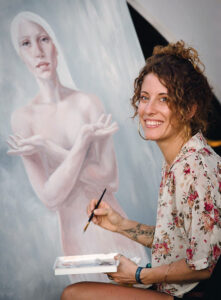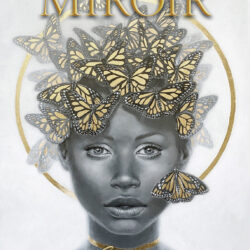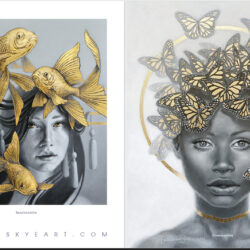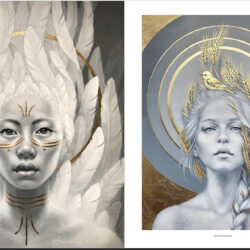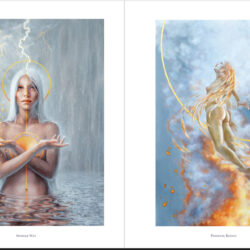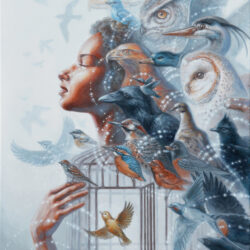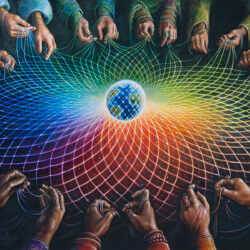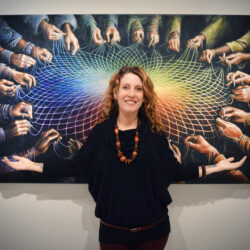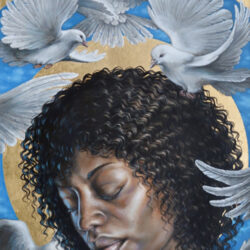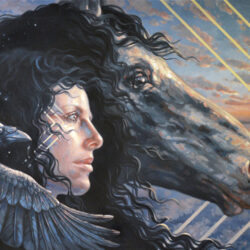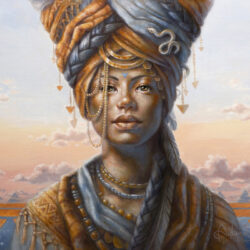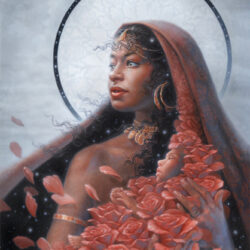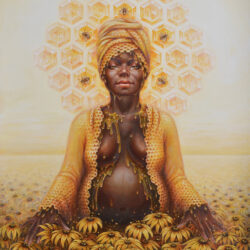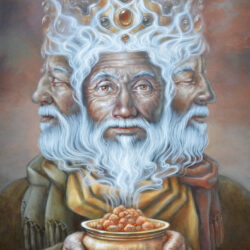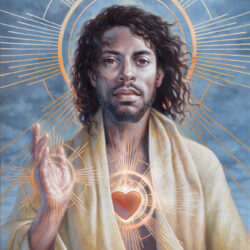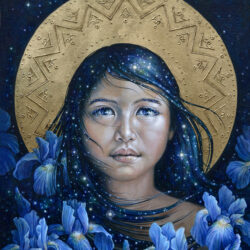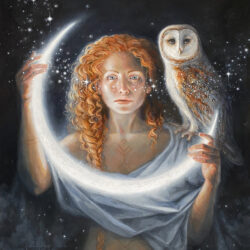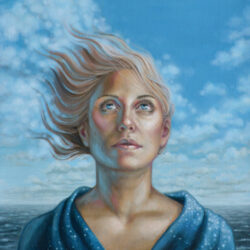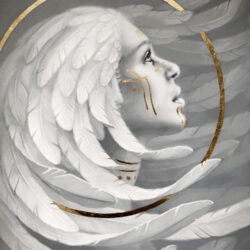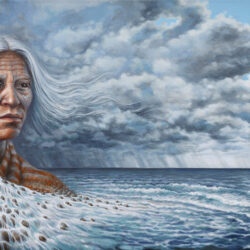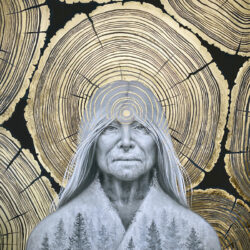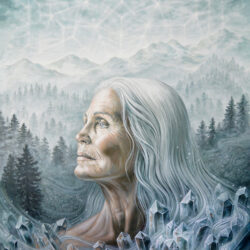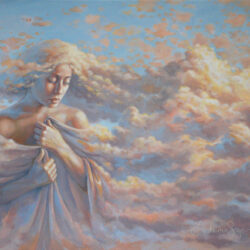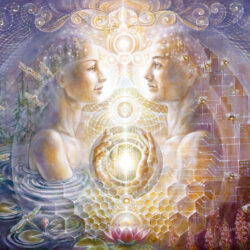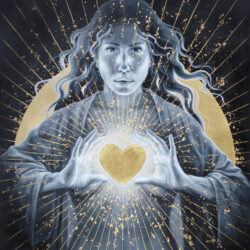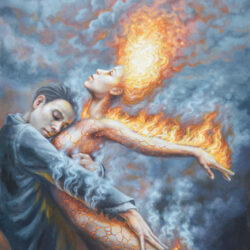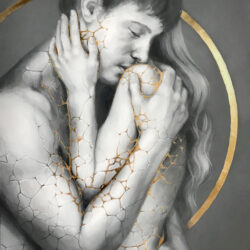Q: How are you inspired to create the powerful and compelling art you are known for?
A: For as long as I can remember, I knew my mission was to share inspiration. As soon as I was old enough to hold a paintbrush in my hand, I began making art, and I have barely put the brush down since. However, inspiration is a difficult energy to pinpoint, and perhaps even more tricky to contrive. The most effective way I’ve found to cultivate inspiration is to sit down at the easel. Just begin. Make art, get messy, have fun, stay curious. Often my best ideas come when I’m working on another piece, in the act of creation, mind at ease and hands and heart engaged. As Picasso said, “Inspiration does exist, but it must find you working.”
Q: What does an image need to have to express or inspire a shift in awareness?
A: Sometimes even the simplest composition can convey incredibly complex concept. I can’t say what exactly makes a paining poignant or evoke emotion. I don’t believe that it’s the contents of the painting, the subject matter, or even the skill involved in its creation that moves people at the deepest level.
While color can certainly direct emotions, craftsmanship can humble us, and and certain shapes of the composition can stir us or capture our attention, there is something much more elusive and mysteriously play. I believe that it is more so the “place“ that the artist was in during its creation. It is like an psychic or energetic imprint on the work that remains tangible far after the artist names it finished and releases it into the world. It is a dance with spirit, and collaboration with the divine.
In any creative expression, there is a profound voice that speaks through us when we release judgment during the process. If we can hone our skill, show up to for the work, and then surrender and listen to our intuition and spirit, we might be able to transmute some magic into our creation.
I realize the art is not born from me, but through me, and in this understanding I am both humbled and empowered. Sure, it takes a lot of hard work and time, but I honestly believe that the more moving my art is, the less I can take credit for it.
Q: Do you begin with a theme in mind, or does it emerge while you are working? What inspires your work, the current political conditions, the environment, the books you read, your dreams, or a conversation with a friend… In other words… does your inspiration come more from internal or external sources?
A: I usually begin each piece with only a loose idea, a seed of a concept, or a few fragmented elements. With such an open starting point, the possibilities are boundless of where the piece will take me. Sometimes it is a little clearer when I begin, and there are only slight surprises as it develops; other times I think I have it “figured out” and suddenly it will shift and flow in a totally different direction.
As a painting develops and evolves, more elements and concepts unfold. I have learned to trust these inspirations, and most often they end up fitting perfectly into the composition and developing theme of the piece. That being said, I also try not to cling to what is already on the canvas, no matter how much time I have dedicated, or how my mind may insist it is too precious to release. Often will spend many hours working on something, only to then suddenly paint over much of it or realize I need to change it into something else. Only when I am able to step back from the painting after it is complete, am I able to witness it from a fresh perspective, and see that everything is in it’s perfect place and it all “makes sense.” The piece tells a story, far beyond what I consciously imagined it ever would. Each painting truly is a journey, and it never ceases to amaze and delight me.
The creation of my paintings is like a waking dream, a dance with inspiration and color, allowing the imagery to unveil itself to me as I journey through the piece. I am a witness. By mentally stepping out of the way, yet staying present consciously, and filled with wonder and delight at each brushstroke. I am peaceful and unaware of passing hours. This process is my greatest teacher and metaphor for how I strive to live my life. When I trust and relax into this amazing process, regardless as to if I understand where I’m going or if it “looks like I planned”, I am gifted and guided in surprising and wondrous ways. In the end, it always makes sense.
Q: Do you need to have the right environment or setting to create a powerful image? If so, what preparations do you make to prepare the surroundings you work in?
A: For as long as I can remember art was always my focus and joy. It has carried on through my life, so by default I have grown very comfortable with integrating my creative process into my daily life. In school, people would watch me draw, and now through my journey in the festival world I find myself painting in front of thousands of people on a somewhat regular basis.
That said, there is a special serene sanctuary available behind closed doors. Painting alone in my studio is one of my absolute favourite places to exist. Just me, my canvas, my thoughts, and whatever music feels right at the time.
The two extremes of public and private cannot be compared however. They both feed my heart and inspiration like an in-breath and out-breath, an ebb and flow.
Regardless of the environment in which I find myself when I sit in front of my canvas, I always take a moment to find my breath. I may have music playing or a candle burning, or I may just be at the kitchen table while my family buzzes around me.
Q: Due to the pandemic, and recent political upheaval (in some countries) there seems to be a need for a new perspective. A New Beginning, Rebirth, A Clean Slate, The Advent of Something Better…. Do you feel it is the artists duty to inspire change? If so in what way do you hope to make a difference in your community or the world at large?
A: I believe that the role of the artist is especially crucial at this challenging and exciting time. While the world is at the precipice of momentous change, artworks have the potential to be maps, and these maps can help guide humanity forward into new and positive ways of seeing and being. Through creativity we have the opportunity to transmute shadow and pain into visions of healing and wholeness.
Q: As an artist, what do you feel indicates success? Is it financial, or a good review, the inclusion in exhibitions, a solo show, publication? Does the bar continue to rise? Or do you feel that success is more internal, a confidence in your craft, a degree of self-satisfaction?
A: Is easy to point at financial prosperity and public recognition as an indication of success, however I believe that it is more subtle than that. To me, the act of creation in itself equates success. Drawing in the sand while you sit at the beach can be success. Painting Easter eggs with your kids can be success. Making dinner can be success.
Success can also when your art sustains the expenses of more supplies, or enables you to pay your bills or even travel. Success can be when someone witnesses your artwork and is emotionally moved or inspired. It can also be when someone purchases one of your paintings and brings it into their home.
It could be argued that success is determined by the number of followers you have on social media, or whether or not you sell your paintings, or have made a coffee table book, or have received awards or public notoriety.
I feel that all of these experiences are facets of the creative journey, and fulfillment does not hinge on any one of them being achieved. I think of “artist“ as a verb, not a noun. It is in the action of making art, no matter the medium nor the professionalism, that one is an artist. Do you make art? If the answer is yes, then you are a successful artist.
Q: Do you have formal training?
A: I can’t really pinpoint what first compelled me to begin making art, other than a cellular and cosmic urge. My mom says that before I could talk or walk I was making pictures, and some of my earliest memories are of drawing. For as long as I can remember I have had a deep mission to create and I was blessed with total support of my artistic exploration while growing up. There was never a doubt of what I would do with my life, and even before I knew the concept of “artist” I feel that I knew who I was and what I was here to do.
I have not completed an academic training, but I have known no more humbling and empowering teacher than art making itself.
Q: Being self-taught, do you feel that the lack of formal training has hindered you in any way? Did you find any road blocks due to a lack of a degree? Do you feel there were advantages by not having a formal teacher, such as a unique perspective without other influences?
A: I have heard many people say that after they completed our college they never painted again. While I do believe in the importance of mentorship, gathering tools and information, studying techniques, and diligent practice, I also believe in spontaneity and intuition. I have witnessed academia as frequently severing or blocking the connection to intuition and Inspiration. It often demands that the creative process come solely from the intellect, and follow the narrow path of concept, research and development, through to execution. The leaves little space for impulse and epiphany. So much of my art making is born in the moment, as the puzzle pieces of the concepts and theme unfold naturally. This is balanced by an appropriate amount of planning send logic. It flows like a dance of the masculine and feminine, focus and wildness, yin and yang. The act of making art is the best teacher you will ever find. Play, experiment, be curious, make a mess!
Q: If you had the power to change the world, to create a new beginning, what would it be, what would you change?
A: While it is romantic and idealistic to imagine how we would create the world given the chance to start over, I would rather start from where we are and find holistic ways to move forward into healing and prosperity. Humanity is on the Hero’s Journey, and through the dark night of the soul we are learning of ourselves and our place in the cosmos. We are learning the importance of honouring the natural world around us and collaborating with others, living in right relations and in harmony. These are hard lessons, and so much has been broken and lost in the process, but through the microcosm of macrocosm we are learning to care for own bodies and spirits, as well as the body and spirit of the planet. We still have a long way to go for a full integration of these lessons, but every day I see proof of this profound evolution in my own relationship with myself, in my home, in my community, and in the world at large.
You can’t go back and make a new start, but you can start right now and make a brand new ending. – C.S. Lewis
Q: What advice do you have for young artists just starting out?
A: Explore the world, go to museums and galleries, and study the works of the Old Masters. Take your sketchbook with you, draw, take notes, and notice what it is about certain pieces that attracts or repels you. Be curious and ask questions. And then… let it all go! Experiment! Break the “rules,” play, and take risks. Remember that every artist is as unique as every viewer. Art is personal, and every aspect of the creation process, as well as every perspective of every viewer thereafter will be unparalleled. In every moment of every day we are absorbing inspiration, from the light reflecting on a puddle, to the hair falling across the friends forehead, to a garbage bag being tossed in the wind. Inspiration is everywhere, and we are constantly learning to see in new ways. These are the subtle ingredients in our art making.
I also very highly recommend attending live figure drawing, as often as possible. There is really no better practice for any artist in any medium, as this builds hand/eye coordination, broadens our understanding of form, light/shadow, line/movement, proportion and anatomy, and our own human bodies. Otherwise, sketch from life: a bottle, a tree, a shoe, a crumpled napkin, or your own hand. Sketch often, and try to draw what you see, not what you think is there. Then, when practiced, drawing from the imagination becomes more convincing, grounded, and powerful. (Even many abstract painters have a long history of realism painting.)
Also, it is so important to actually use high quality tools and supplies. Of the three main aspects, paints, brushes, and surfaces; paints are the most important to invest in quality. Honestly, you can paint on a shirt or a rock if you need to, and though expensive new paintbrushes are lovely to work with, even your finger or a stick can do the trick if you have no other tool. However, if you are using cheap pigments (paint colours) they will only turn to “mud” when you attempt to mix colors, and often will fade over time, or be susceptible to moisture damage. Investing in quality tools and supplies is like the difference between learning to play an instrument on a toy or on a professionally crafted instrument. It is the difference between giving up or continuing.
Anyhow, besides all that, just have fun; create art for you, first and foremost, and for the healing of our world.
Q: Do you feel that the community: local, state or government needs to be more supportive of the arts? If so, in what way?
A: I think that more emphasis, support, and funding for the arts would be a huge benefit to community and culture. It always perplexed me that the arts are so underrepresented and are usually the first department to get cut in education and social funding. I feel that the undervaluing of art is what perpetuates the concept of staving artist. With more importance and appreciation put towards the arts, it would further inspire the youth towards artistic passions. It would also empower the use of creativity in the daunting task of systems reformation and solutions for the environmental, political, and social challenges currently facing our world.
Q: Have you had the opportunity to benefit from grants or commissions funded by the state or government or private institutions? If so, can you share your experiences?
A: I have never received government grants or funding, essentially because I have never asked for it due to the fact that I do not feel I am “in need“. I have worked a full-time job since my very early teens, and have always had an entrepreneurial mind and a creative business sense. I am so glad to know that grants are available to people who need a leg up and who could really benefit from the extra support. I am grateful and privileged to have a thriving art business that supports me and further supports my community through employment.
Q: If there is any topic or question, we did not ask, feel free to create your own question and answer for this interview.
A: Since my childhood adventured across the vast wilderness of Canada, down into the mysterious and enchanting landscapes of the United States, and along the awe inspiring coasts of Mexico, I have been enthralled by this magnificent and diversely adorned Earth. This eager exploration and appreciation continued after high-school and brought me to South-East Asia and Mexico, and Europe. Wherever I travel, I take my sketchbook and diary, musing romantically and critically about how we live on the planet, how humans interact with our surroundings and each other, and what makes us uniquely different and the universally same. I witness the striving, the longing, the suffering; and at the same time I see the generosity, the hope, the reverence for life. It is this paradox that permeates the divine comedy of this existence. We are each the villain and the hero, it is a matter of perspective. This perspective is what I gratefully fold into the pages of my sketchbook and the archives of my memory, and when I return home from countless miles and distant continents, I unfurl the inspiration onto the awaiting canvases of my studio.



